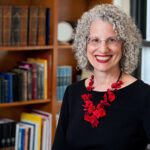A Pesah Message from Chancellor Schwartz
Chancellor Schwartz shares how we can find ourselves in each of the four children in the seder.

The Pesah seder has long been the most observed Jewish ritual by American Jews, and many look forward all year long to gathering with loved ones, friends, and community members. We come together for good food and company and to recount and discuss the religiously, intellectually, spiritually, and emotionally complex experiences at the heart of the Israelite liberation from Egypt and the formation of the Jewish people.
This year our anticipation is mixed with heartbreak and heaviness that we can’t shake. Israel has been traumatized by the massacre of October 7, Israeli hostages remain in captivity, the country is at war—with the bombardment from Iran freshest in our minds—and we remain fearful for what may come next. The humanitarian crisis in Gaza tears at our hearts as well. Moreover, we’ve experienced a dramatic rise in antisemitism in North America and worldwide, leaving us feeling vulnerable and concerned. We may also feel anxious about how varying perspectives on each of these matters will impact this year’s seder experience.
For me, the variety of human responses is best represented in the brilliant illustration of the four children in the Feast of Freedom Haggadah edited by Rachel Anne Rabinowicz. The four children are depicted as nondescript human adults, each a unique patchwork of four colors: royal blue, orange, red, and navy. All four colors appear in all four humans but in different-sized shapes and positions. Without a single word, the illustration offers a thought-provoking midrash, providing an astute commentary on the Haggadah’s characterization of the four children. Rather than four children with distinct and, at times, opposing personalities, the illustration suggests that all humans are wise, evil, simple, and unknowing and that each of us embodies these aspects to varying degrees and at different times in our lives.

(Israel, 1982)
Perhaps this illustration also comes to teach us that certain situations especially elicit our wisdom, stubbornness, curiosity, or ignorance. Or that our own ego does not allow us to confront vulnerability in areas where our own wisdom is lacking and that we must learn to seek guidance from others with different life experiences or knowledge. Each of the questions that the four children ask in the Haggadah comes directly from the Torah, though each represents a different point of view. This calls to mind the ancient parable of four visually impaired people encountering an elephant for the first time. By grabbing a leg, one concludes it is a tree trunk; another holds the tail and assumes it is a whip. The third person touches the elephant’s trunk and decides it is a hose, while the fourth person pats the elephant’s side and imagines it is a wall. The onlooker tells them, “All of you are right.”
What guards us, then, from the same type of atomized experience recounted in the parable, each person with their own unique and intractable truth? It’s a fact that each of these questions is posed when everyone is sitting at the same table, in relationship and community. The verses are phrased in such a way that there is an expectation that all of us will eventually ask each of the questions that fulfill the four archetypes. It is not a question of “Which child am I?” It is a question of “Which part of me am I channeling in this unique moment of my life?”
This all makes good sense psychologically, but it’s hard to wrap my head around the harshness of the word rasha (רשע; wicked)—not errant, rebellious, or defiant, but wicked. Furthermore, we are to subject this particular child to punishment, as the Haggadah tells us to blunt the child’s teeth and say, “This is done for what Adonai did for me when I went out of Mitzrayim.” The response goes further, noting that had the questioner been in Mitzrayim, they would not have been redeemed. Why such severe repercussions for someone who has chosen to participate in the seder, a ritual that encourages questioning?
My understanding of this builds on Rabbi Elijah Gaon’s teaching in his commentary on the Haggadah. Utilizing Gematria, Hebrew numerology, the Gaon teaches that when we subtract the value of the Hebrew word שניו (his teeth) from the Hebrew word for רשע (wicked), we have a צדיק (righteous one). In other words, when you remove the child’s “biting words,” a righteous person emerges. This interpretation reinforces the view that people encompass many seemingly contradictory qualities. Under a rasha is a tzadik who may need a caring teacher, a loving parent, or a curious friend to recognize their goodness. An attentive listener is able to filter out the defiance and hear the words of an earnest questioner.
This Pesah, may we open our arms to all our children and seder guests—whatever their age, perspective, politics, beliefs, or observance level. Let’s encourage and listen to one another’s questions. Let’s seize the opportunity to soften our perspectives and make room to listen to others. Fully embracing the inquisitive exchange of questions is the hallmark of the seder. Doing so can help us break down the silos of difference and discover the truth of our commonality.
For specific suggestions on how to best prepare for such conversations, please read this thoughtful guide by Rabbi Jan Uhrbach, director of JTS’s Block / Kolker Center for Spiritual Arts.
The vibrancy of Judaism has always hinged on keeping our tradition alive through intergenerational storytelling and refreshing our tradition, by questioning discussion, and through experimentation. May we together chart a path toward a more hopeful future.
I wish you a Hag Kasher v’sameah, and a sweet Pesah.



